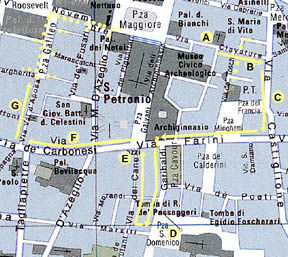

Start with Le Marie Piangente sul Cristo Morto (1463) by Nicolò dell'Arca, in the church of Santa Maria della Vita (Via Clavature, 10), just a few steps away from Piazza Maggiore.
Exit the church to the left on Via Clavature towards Via Castiglione. Explore the Mercato Coperto and tiny side streets: Via Clavature (locksmiths); Via Orefici (goldsmiths); Via Spadari (sword-makers); Via Pescherie Vecchie (fish); Via Caprarie (meat); Via Drapperie (textiles); and Via Calzolerie (shoes). Notice evolution of porticoes on the left just after Via Drapperie (n. 16-18).
Turn right at Via Castiglione towards the Palazzo Pepoli (n. 4). Notice the black and white checkerboard heraldic shield and the heavy iron serpent-like hooks and rings about five feet up from the pavement for mooring the boats that once traveled the canal here. Continue towards Via Farina where the Ponte di Ferro (iron bridge) once crossed the canal
Go right on Via Farini, once known as Via dei Libri (books), toward Piazza Calderini. Turn left at Piazza Cavour onto what will become Via Garibaldi. This was Via delle Cassette di Sant'Andrea, where the law students used to attend their lessons at the professors' quarters.
River stones that recall a medieval past cover Piazza San Domenico. Two copper statues on top of high columns stand there, the one in the center of San Domenico (1627, designed by Guido Reni) and the other of the Madonna (1632, Giulio Cesare Conventi). The tombs honor Rolandino de'Passeggeri, an important notary and government official (1305), and Egidio Foscherari, an expert in Church Law (1289). San Domenico himself adorns the lunette to the church.
Inside the church, the sixth chapel on the right is the white marble tomb of San Domenico. From 1265-1267 Nicola Pisano worked with others less famous to carve the saint's sarcophagus. Nicolò dell'Arca (1469-1473) added the magnificent marble crown to the sarcophagus, considerd his capolavoro. Note the two torch-bearing angels on the front of the altar slab. On the left is that of Nicolò dell'Arca. On the right is that of Michelangelo. Michelangelo also authored two other statues surrounding the crown of the tomb: the Roman soldier San Procolo and San Petronio holding Bologna in his hands.
Handwritten signs direct one to the choir (coro) of inlaid wood created by monk Damiano da Bergamo (1528-1551).
Exit the church and cross the piazza and Via Garibaldi to take Via Marsili heading west. Palazzo Fava-Marescotti is at the corner with Via del Cane. Meander towards Via Carbonesi.
Go left on Via de'Carbonesi to the COIN department store, n. 7, between Via D'Azeglio and Via D'Aposa. Inside are the ruins of a Roman Theater. To the left, upon exiting the store, is the the chocolate world of Majani.
Turn right from Majani onto Via de'Carbonesi. Turn right on Via Val D'Aposa, named after one of the rivers that formed part of the Bologna's canal system in the Middle Ages. A short distance ahead on the right is the Oratorio of the Holy Spirit, erected by the Celestines from 1481 to 1497. Return toward Piazza Maggiore again.